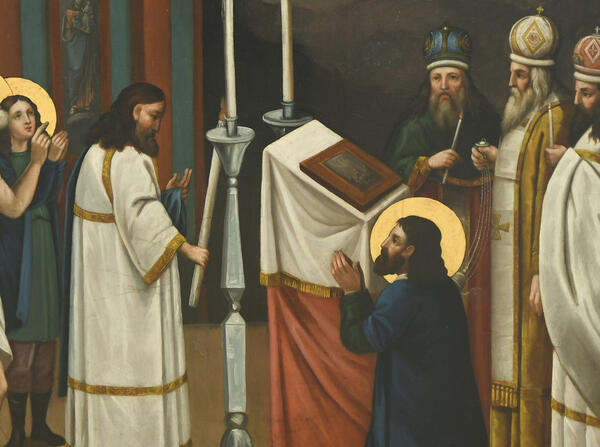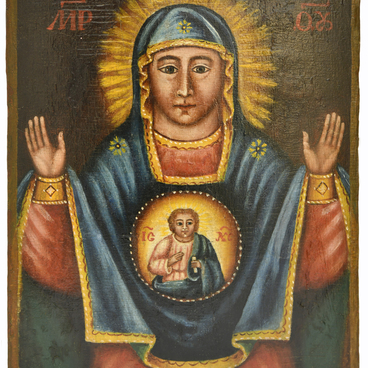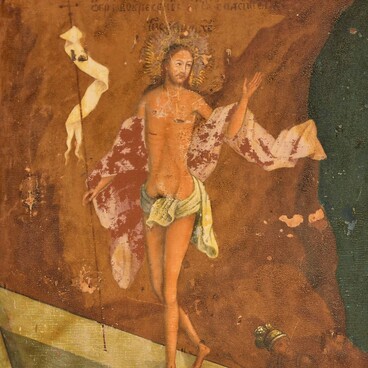The Intercession of the Mother of God is one of the main church holidays in Orthodoxy. It is celebrated on October 14. This tradition developed in the 12th century, and the first icons of this feast appeared in the 14th century. The holiday is based on the legend of how the Virgin Mary appeared to St. Andrew the Fool for Christ in the temple of Blachernae, a suburb of Constantinople. In the hagiography of the saint, it was said that the Mother of God appeared to the parishioners during a church service and extended her omophorion above them — a broad white scarf, traditionally worn around the neck.
The icon of the Intercession of the Mother of God from the collection of the Bishop’s House consists of two parts. In the center of the upper row, the Virgin Mary stands on the clouds: she wears a dark blue chiton and a red headscarf — a maphorium. There is a halo of shining rays around her head. The Virgin looks at the saint kneeling in front of her.
The lower part shows the interior of the temple with icons on the walls. There is an icon on the lectern — a church table covered with a white cloth. There are two floor candle holders nearby with burning candles. A saint in a blue robe kneels before the lectern, his hands are folded in a gesture of prayer. There are three clergymen in bishop’s robes on the right. On the left, there is Romanus the Melodist dressed in white robes, a Christian saint, the author of many solemn hymns, which can still be heard at Orthodox church services. Andrew the Fool-for-Christ stands behind Roman’s back, he wears a loincloth. He points to the Virgin Mary in the clouds showing the miracle to his disciple Epiphanius.
The icon of the Intercession of the Mother of God from the collection of the Bishop’s House consists of two parts. In the center of the upper row, the Virgin Mary stands on the clouds: she wears a dark blue chiton and a red headscarf — a maphorium. There is a halo of shining rays around her head. The Virgin looks at the saint kneeling in front of her.
In her outstretched arms, she holds a white omophorion embroidered with golden crosses. Behind the Virgin’s back, there is numerous retinue: it includes John the Baptist, John the Theologian, other saints, and angels. In the upper left corner the Lord Almighty in a red chiton and blue cloak, a himation sits on the cloud. He has the same halo around his head as that of the Virgin. Christ’s left hand rests on the cloud; his right hand is extended forward in the gesture of blessing.
The lower part shows the interior of the temple with icons on the walls. There is an icon on the lectern — a church table covered with a white cloth. There are two floor candle holders nearby with burning candles. A saint in a blue robe kneels before the lectern, his hands are folded in a gesture of prayer. There are three clergymen in bishop’s robes on the right. On the left, there is Romanus the Melodist dressed in white robes, a Christian saint, the author of many solemn hymns, which can still be heard at Orthodox church services. Andrew the Fool-for-Christ stands behind Roman’s back, he wears a loincloth. He points to the Virgin Mary in the clouds showing the miracle to his disciple Epiphanius.



